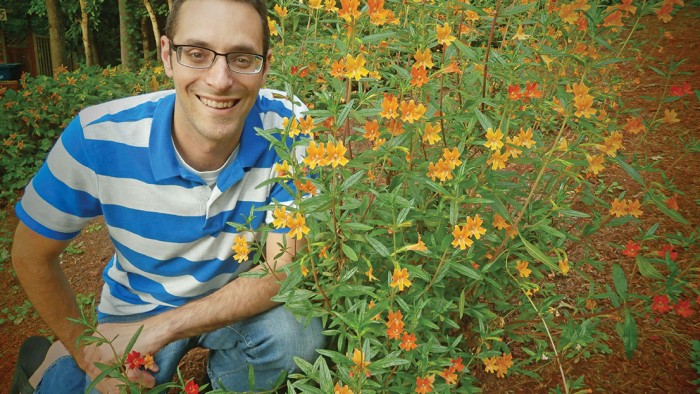 Natural Sciences
Natural Sciences
The Mystery of the Monkey Flower

Throughout California, an unassuming wildflower grows in shades of yellow and orange. But in the southernmost part of the state near San Diego, its petals are red.
To most, the change in color of the monkey flower would go unnoticed. But for Matt Streisfeld and his students, the flower provides a glimpse into evolutionary history.
“There’s a small area in the extreme southwestern part of California where all the monkey flowers are red. Just 30 miles inland, the flowers are all yellow,” said Streisfeld (above), an assistant professor of biology who leads a lab in the Institute of Ecology and Evolution. “What’s unique is that in a small transition area, the flowers are hybrid and have mixed orange colors, but only there. Why does the transition happen right there? By studying the monkey flower, we are trying to understand the underlying evolutionary mechanisms that tell us how species form.”
The flower’s geographic idiosyncrasies translate well for work in Streisfeld’s laboratory and greenhouse, where students immerse themselves in the inner workings of biology research. Students join Streisfeld in trying to better understand the diversity among species and the process of adaptation.
“Classwork is great, but to understand the process of how science is conducted, there is nothing more important than doing lab work,” said Streisfeld, who has undergraduate, graduate, and postdoctoral students working in his lab. “Science is an incremental process and lab work leads students through the process of coming up with ideas, designing and conducting experiments, analyzing data, and communicating findings.”
 Connor Benson (left) started working in Streisfeld’s lab in fall 2013, after becoming interested in evolutionary biology. Benson started with general lab tasks such as working in the greenhouse, prepping for experiments, and sterilizing equipment. Then, he worked with Streisfeld to develop a biology honors thesis, an independent project related to the lab’s overall research.
Connor Benson (left) started working in Streisfeld’s lab in fall 2013, after becoming interested in evolutionary biology. Benson started with general lab tasks such as working in the greenhouse, prepping for experiments, and sterilizing equipment. Then, he worked with Streisfeld to develop a biology honors thesis, an independent project related to the lab’s overall research.
His project was a study that followed up on previous work in the lab on the genetic basis for the flower color change. While Streisfeld has shown that one major gene controls the change, Benson’s project was to test the function of additional genes that also may regulate production of the floral pigment.
Benson’s results ended up contradicting the established research, but he was undaunted, noting that unexpected outcomes also help push knowledge forward. His work has opened several new lines of inquiry that Streisfeld expects to carry on with other students.
“I really enjoy working with the students and seeing them grow as scientists,” Streisfeld said. “I see them invest themselves and delve into projects and pull out information in the end. I think they learn a whole lot more than what can be taught in the classroom.”
Working in a lab helped Benson earn his honors biology degree in June and, equally as important, enriched his collegiate experience.
“The lab gives you a mode of thinking that you don’t get in classes,” he said. “You get to see the entire process of experimental design, data collection, analysis, and in some cases publication, which really brings the whole process of biology and science together.”
—By Heidi Hiaasen


 Twitter
Twitter Facebook
Facebook Forward
Forward